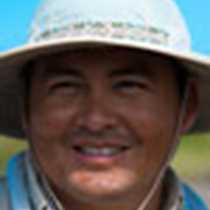After five days cruising remote islands in the western part of the Galápagos, exploring flora and fauna, the National Geographic Islander arrived in Academic Bay, located on the south side of Santa Cruz Island, to meet local islanders and learn about the culture of the Galápagos.
This morning, we disembarked at Puerto Ayora. Known as the metropolis of the Galápagos Islands, Puerto Ayora was settled by Norwegians farmers in 1926. Most of its 18,000 inhabitants work in ecotourism or sustainable fishing and agriculture.
First, we headed to the Fausto Llerena giant tortoise breeding center located in the headquarters of Galápagos National Park. To understand conservation efforts to restore native populations of giant tortoises, we peered into rustic corrals that house species from Santa Cruz, Santiago, Espanola, and Pinzon islands. The goal is to breed these species in captivity and later release them into areas where their population has dwindled due to encroachment by humans and alien species.
Unfortunately, the last surviving tortoise from Pinta Island, George, died in June 2012, leaving an empty place in the hearts of the community of Galápagos and scientists trying to save the Pinta Island species from extinction. Although George is gone, there is another tortoise hero named Super Diego, who has helped restore the tortoise population of Espanola Island. This most successful breeding program has produced more than 2,000 tortoises since 1976, when there were only 14 adult tortoises found on Espanola.
Later in the morning, we walked back to town and passed by the fishing market where fishermen showed the catch of the day. Some of our guests interacted with graceful sea lions, pelicans, herons, and frigatebirds begging for free fish.
Afterward, while traveling on buses to the highlands, we enjoyed different vegetation zones. We also made a quick stop at a private farm to learn about the processing of sugarcane. Besides sampling sugarcane juice and the Ecuadorian liquor punta, we also tried organic local coffee. After riding a bus for 20 minutes and counting tortoises crossing the main road to the highlands, we arrived at El Chato restaurant, where a delicious lunch awaited us.
In the afternoon, we took a walk in a lava tube that formed 1.5 million years ago when the volcano on Santa Cruz was very active. We also found gigantic tortoises in a National Park reserve that had made their way to private farms. Walking through the humid zone with dense vegetation was unexpected since we had been in the coastal zone for most of the day. Finding giant tortoises in their natural habitat was a great way to complete our adventure on Santa Cruz Island.






